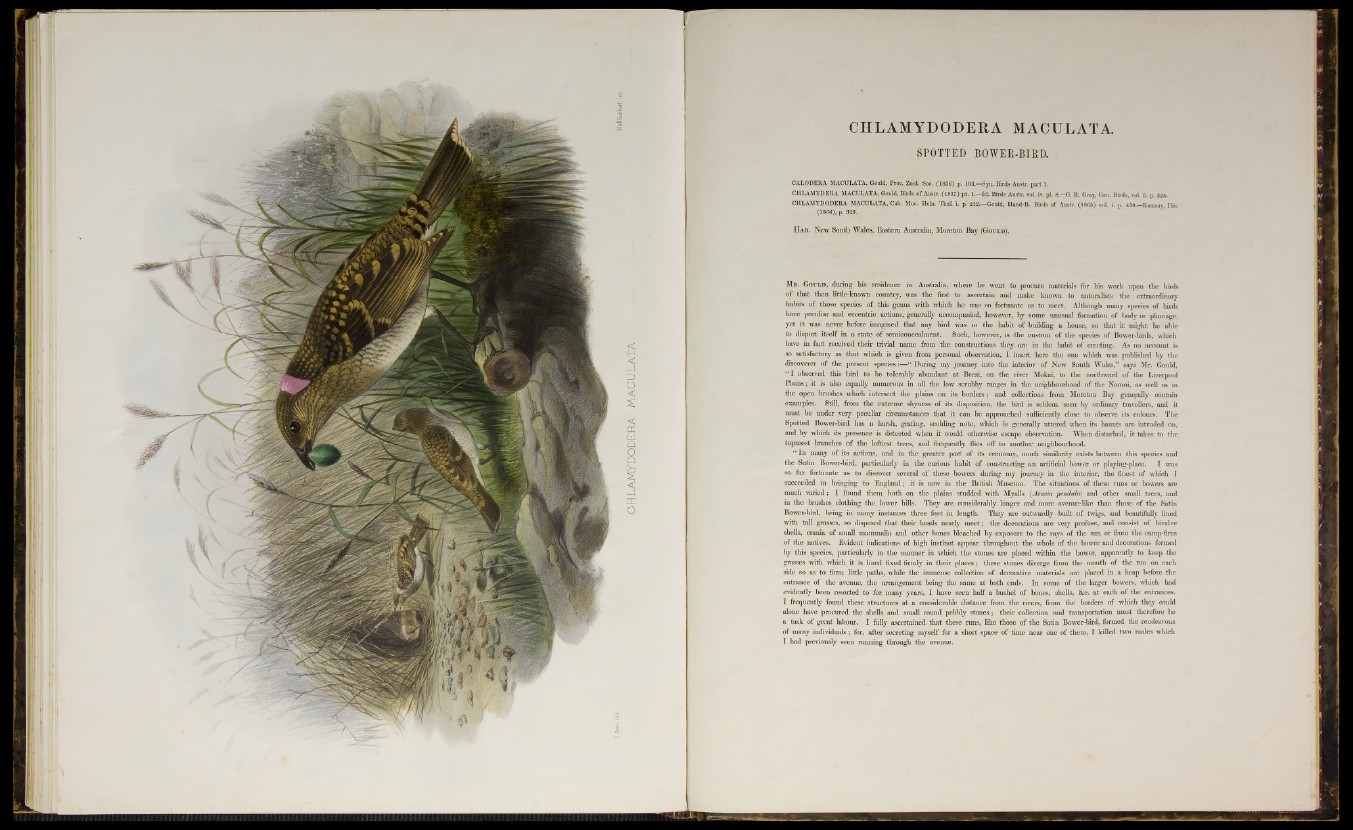
CHLAMYDODERA MACULATA
CHLAMYDODERA MACULATA
SPOTTED BOWER-BIRD.
CALODERA MACULATA, Gould, Proc. Zool. Soc. (1836) p. 106.—Syn. Birds Austr. part 1.
CHLAMYDERA MACULATA, Gould, Birds o f Austr. (1837) pt. 1.—Id. Birds Austr. vol. iv. pi. 8.—G. R. Gray, Gen. Birds, vol. ii. p. 326.
CHLAMYDODERA MACULATA, Cab. Mus. Hein. Theil i. p. 212.—Gould, Hand-B. Birds o f Austr. (1865) vol. i. p. 460.—Ramsay, Ibis
(1866), p. 329.
H a b . New South Wales, Eastern Australia, Moreton Bay (G o u ld ) .
M b . G o u ld , during his residence in Australia, where he went to procure materials for his work upon the birds
of that then little-known country, was the first to ascertain and make known to naturalists the extraordinary
habits of those species of this genus with which he was so fortunate as to. meet. Although many species of birds
have peculiar and eccentric actions, generally accompanied, however, by some unusual formation of body or plumage,
yet it was never before imagined that any bird was in the habit of building a house, so that it might be able
to disport itself in a state o f semiconcealment. Such, however, is the custom of the species of Bower-birds, which
have in fact received their trivial name from the constructions they are in the habit of erecting. As no account is
so satisfactory as that which is given from personal observation, I insert here the one which was published by the
discoverer o f the present species:—“ During my journey into the interior, of New South Wales,” says Mr. Gould,
“ I observed this bird to be tolerably abundant at Brezi, on the river Mokai, to the northward of the Liverpool
Plains; it is also equally numerous in all the low scrubby ranges in the neighbourhood of the Namoi, as well as in
the open brushes which intersect the plains on its borders; and collections from Moreton Bay generally contain
examples. Still, from the extreme shyness of its disposition, the bird is seldom seen by ordinary travellers, and it
must be under very peculiar circumstances that it can be approached sufficiently close to observe its colours. The
Spotted Bower-bird has a harsh, grating, scolding note, which is generally uttered when its haunts are intruded on,
and by which its presence is detected when it would otherwise escape observation. When disturbed, it takes to the
topmost branches of the loftiest trees, and frequently flies off to another neighbourhood.
“ In many of its actions, and in the greater part of its economy, much similarity exists between this species and
the Satin Bower-bird, particularly in the curious habit of constructing an artificial bower or playing-place. I was
so far fortunate as to discover several of these bowers during my journey in the interior, the finest of which I
succeeded in bringing to England; it is now in the British Museum. The situations of these rims or bowers are
much varied; I found them both on the plains studded with Myalls (Acacia pendula) and other small trees, and
in the brushes clothing the lower hills. They are considerably longer and more avenue-like than those of the Satin
Bower-bird, being in many instances three feet in length. They are outwardly built of twigs, and beautifully lined
with tall grasses, so disposed that their heads nearly meet; the decorations are very profuse, and consist of bivalve
shells, crania of small mammalia and other bones bleached by exposure to the rays of the sun or from the camp-fires
of the natives. Evident indications of high instinct appear throughout the whole of the bower and decorations formed
by this species, particularly in the manner in which the stones are placed within the bower, apparently to keep the
grasses with which it is lined fixed firmly in their places; these stones diverge from the mouth of the run on eaeh
side so as to form little paths, while the immense collection of decorative materials are placed in a heap before the
entrance o f the avenue, the arrangement being the same at both ends. In some of the larger bowers, which had
evidently been resorted to for many years, I have seen half a bushel of bones, shells, &c. at each of the entrances.
I frequently found these structures at a considerable distance from the rivers, from the borders of which they could
alone have procured the shells and small round pebbly stones; their collection and transportation must therefore be
a task of great labour. I fully ascertained that these runs, like those of the Satin Bower-bird, formed the rendezvous
of many individuals; for, after secreting myself for a short space of time near one of them, I killed two males which
I had previously seen running through the avenue.